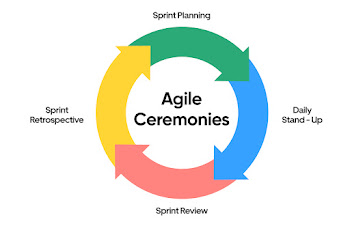What are the different ceremonies in Agile?
Agile ceremonies are formal meetings or events held within an Agile development process to ensure transparency, collaboration, and progress. These recurring gatherings keep everyone informed, aligned, and focused on delivering value throughout the project life-cycle.
Here are the four most common Agile ceremonies:
1.Sprint Planning:
This meeting marks the beginning of a new sprint (a short development cycle). The development team, along with the product owner, collaboratively plan the tasks for the upcoming sprint.
Activities:
- The product owner presents the product backlog, a prioritised list of features and functionalities for the product.
- The development team selects user stories (requirements) from the top of the backlog and estimates the effort required to complete them within the sprint time-frame. This estimation is often done using relative sizing techniques.
- The team collaboratively defines clear and measurable goals for the sprint, ensuring everyone is aligned on what needs to be achieved.
2.Daily Stand-up (Daily Scrum):
- Each team member answers three questions:
- What did I accomplish yesterday?
- What will I work on today?
- Are there any roadblocks impeding my progress?
- Discuss and address any roadblocks or dependencies that might hinder progress.
- Ensure everyone is aware of the team's progress and potential challenges.
3. Sprint Review:
Held at the end of each sprint, this meeting allows the development team to showcase the completed work to stakeholders and gather feedback.
Activities:
- The development team demonstrates the features or functionalities delivered during the sprint.
- Stakeholders provide feedback on the work and discuss any potential adjustments for future sprints.
- The product owner reviews the feedback and may refine the product backlog based on learning and priorities.
4. Sprint Retrospective:
This meeting, also held at the end of each sprint, focuses on continuous improvement. The development team reflects on the past sprint, identifying what went well, what could be improved, and how to optimise their approach for future sprints.
Activities:
- Discuss what worked well during the sprint and what areas can be improved.
- Identify and address any process bottlenecks or challenges faced by the team.
- Brainstorm and agree on actions to enhance team performance and overall effectiveness in future sprints.



Comments
Post a Comment